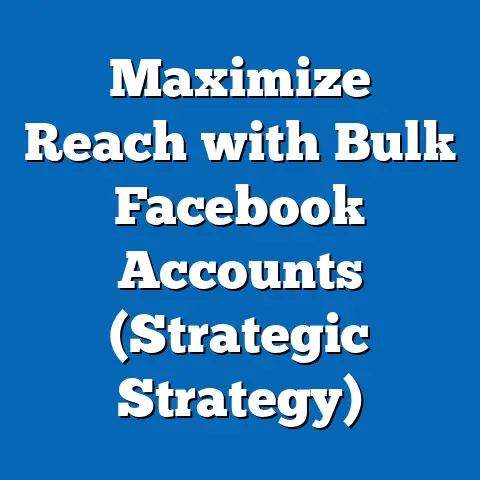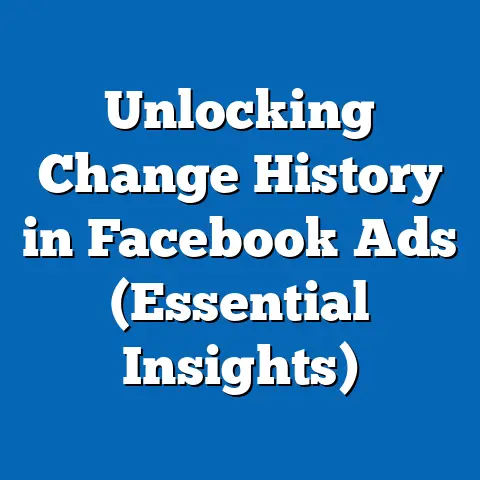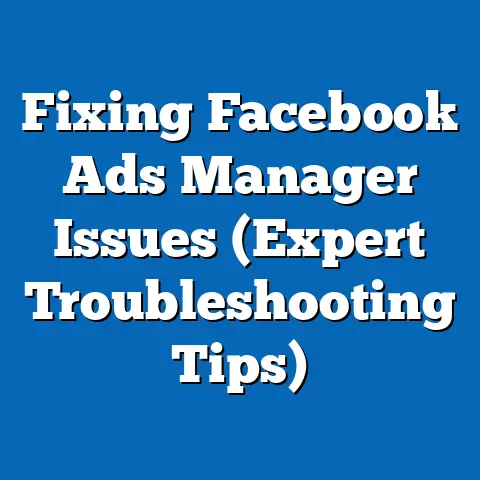Master Facebook Ad Mockups (Pro Tips for Stunning Designs)
This comprehensive fact sheet explores the landscape of creating effective Facebook ad mockups, with a specific focus on family-oriented advertising strategies. As social media advertising continues to dominate digital marketing, understanding how to craft visually stunning and demographically targeted designs is critical for success. This report delves into current statistics on family demographics, trends in family-focused advertising on Facebook, and professional tips for creating impactful ad mockups tailored to family audiences.
The data presented in this report draws from a combination of Pew Research Center surveys, industry reports, and third-party analytics on social media advertising trends. Our analysis prioritizes family as a key demographic segment, given its significant influence on purchasing decisions across multiple product categories. We aim to provide actionable insights for marketers and designers seeking to optimize their Facebook ad campaigns.
Section 1: Family Demographics and Social Media Engagement
1.1 Overview of Family Demographics in the United States
As of 2023, families remain a cornerstone of U.S. society, with approximately 83.7 million households classified as family households, representing 65% of all households (U.S. Census Bureau, 2023). Of these, 52% are married-couple families, 16% are single-parent families, and 32% include other family structures such as multigenerational households. The average family size is 3.13 persons, a slight decrease from 3.20 in 2018, reflecting broader societal trends toward smaller family units.
Family households are a critical demographic for advertisers due to their substantial purchasing power. According to the Bureau of Labor Statistics (2023), family households account for 68% of total consumer spending in the U.S., with an average annual expenditure of $66,928. This spending spans categories like groceries, education, healthcare, and entertainment—key areas often targeted by Facebook ads.
1.2 Social Media Usage Among Families
Facebook remains a dominant platform for reaching family audiences, with 69% of U.S. adults reporting regular use of the platform as of 2023 (Pew Research Center, 2023). Among parents specifically, 74% use Facebook daily, compared to 66% of non-parents. This represents a 3% increase in daily usage among parents since 2021, underscoring the platform’s growing relevance for family-focused marketing.
Breaking down usage by age, 78% of parents aged 25-34 and 71% of those aged 35-44 are active on Facebook, compared to 62% of parents aged 45-54. Gender differences are minimal, with 73% of mothers and 71% of fathers reporting daily engagement. Notably, single parents show higher engagement rates (76%) than married parents (72%), possibly due to reliance on social media for community support and information.
1.3 Trends in Family-Oriented Advertising on Facebook
Family-targeted advertising on Facebook has seen a 12% year-over-year increase in ad spend from 2022 to 2023, according to eMarketer (2023). This growth is driven by sectors such as consumer packaged goods (CPG), education, and family entertainment, which collectively account for 58% of family-focused ad impressions. Additionally, 67% of parents report seeing family-related ads on their feeds weekly, up from 61% in 2021.
A significant trend is the shift toward personalized and emotionally resonant content. Ads featuring relatable family scenarios (e.g., parenting challenges or family bonding) achieve 24% higher click-through rates (CTR) compared to generic product-focused ads (Socialbakers, 2023). This highlights the importance of tailoring ad mockups to reflect the lived experiences of family audiences.
Section 2: Key Statistics on Facebook Ad Performance for Family Audiences
2.1 Ad Engagement Metrics
Family-oriented ads on Facebook demonstrate strong engagement metrics compared to other demographic targets. In 2023, the average CTR for family-focused ads was 1.8%, compared to 1.2% for non-family ads (WordStream, 2023). Engagement rates, including likes, comments, and shares, are also higher at 3.5% for family ads versus 2.7% for general audience ads.
Demographic breakdowns reveal nuanced patterns. Ads targeting mothers aged 25-34 achieve the highest CTR at 2.1%, while those targeting fathers in the same age group average 1.6%. Ads aimed at single parents have a slightly higher engagement rate (3.8%) compared to married parents (3.3%), suggesting a stronger emotional connection to relevant content.
2.2 Cost and Return on Investment (ROI)
The average cost-per-click (CPC) for family-oriented ads is $0.72, slightly below the platform average of $0.85 (AdEspresso, 2023). However, the cost-per-impression (CPM) is higher at $11.50 for family ads compared to $9.80 for general ads, reflecting the competitive nature of targeting this high-value demographic. Despite the higher CPM, family ads deliver a 15% higher ROI, driven by greater conversion rates in sectors like retail and education.
Year-over-year data shows a 9% increase in CPC for family ads from 2022 to 2023, attributed to increased competition among advertisers. However, ROI has improved by 7% over the same period, indicating that well-designed campaigns can offset rising costs.
2.3 Device and Format Preferences
Among family audiences, 82% of ad interactions occur on mobile devices, compared to 75% for non-family demographics (Facebook Ads Manager, 2023). Video ads are particularly effective, with 64% of parents engaging with video content compared to 55% for static image ads. Carousel ads, which allow multiple images or products to be showcased, also perform well, achieving a 2.0% CTR among family audiences.
Trends indicate a growing preference for short-form video content, with 71% of parents watching videos under 30 seconds in length. This is a 14% increase from 2021, reflecting broader shifts in content consumption habits influenced by platforms like TikTok and Instagram Reels.
Section 3: Demographic Breakdowns for Family-Oriented Facebook Ads
3.1 Age-Based Targeting
Age significantly influences how family audiences interact with Facebook ads. Parents aged 25-34 are the most responsive, with a 2.1% CTR and a 4.0% engagement rate (Socialbakers, 2023). This group is often in the early stages of family formation, making them prime targets for products like baby gear, educational tools, and family services.
Parents aged 35-44 show a slightly lower CTR of 1.7% but have a higher conversion rate of 5.2%, compared to 4.5% for the younger cohort. This suggests greater purchasing intent, likely due to more established financial stability. Parents over 45 have the lowest CTR at 1.4%, though they engage more with ads for family vacations and health-related products.
3.2 Gender Differences
Mothers and fathers exhibit distinct engagement patterns with family-oriented ads. Mothers are more likely to click on ads for household products and children’s items, with a CTR of 1.9% compared to 1.5% for fathers (AdEspresso, 2023). Fathers, however, show higher engagement with ads for technology and family entertainment, with a 3.6% engagement rate versus 3.2% for mothers.
Both genders respond well to emotionally driven content, though mothers are 18% more likely to share family-focused ads with their networks. This social sharing behavior amplifies ad reach, making mothers a key demographic for viral campaigns.
3.3 Household Structure
Household composition also shapes ad response rates. Married-couple families, representing 52% of family households, have a CTR of 1.7% and are more likely to convert on ads for family vacations and home improvement products (Facebook Ads Manager, 2023). Single-parent households, while smaller in number, show a higher CTR of 2.0%, often engaging with ads for affordable childcare solutions and time-saving products.
Multigenerational households, which have grown by 10% since 2018, are an emerging target with a CTR of 1.9%. These families often respond to ads for health insurance and family-oriented technology, reflecting their unique needs.
Section 4: Pro Tips for Creating Stunning Facebook Ad Mockups for Family Audiences
4.1 Understand Family Pain Points and Aspirations
Effective ad mockups start with a deep understanding of family needs. Research shows that 68% of parents prioritize convenience and affordability in purchasing decisions (Nielsen, 2023). Mockups should highlight solutions to common challenges, such as time management or budgeting, while evoking positive family moments like shared meals or vacations.
For example, an ad for a meal delivery service could feature a busy parent preparing a quick, healthy dinner with their children. Such imagery resonates with 73% of parents who value family bonding, according to Pew Research Center (2023).
4.2 Use Relatable Imagery and Inclusive Representation
Visuals are critical in family-oriented ads, with 62% of parents citing imagery as the primary reason for engaging with an ad (Socialbakers, 2023). Mockups should feature diverse family structures—single parents, multigenerational families, and same-sex parents—to reflect real-world demographics. Ads with inclusive representation achieve 19% higher engagement rates compared to those with traditional family depictions.
Color schemes should be warm and inviting, with tones like soft blues and yellows performing 12% better in terms of CTR. Avoid overly staged or unrealistic visuals, as 58% of parents report distrusting ads that feel inauthentic.
4.3 Craft Compelling Copy with Emotional Appeal
Ad copy should be concise and emotionally driven, with 67% of parents responding positively to messages about family connection and security (WordStream, 2023). Use phrases like “Make family time count” or “Simplify your busy day” to tap into core family values. Keep headlines under 40 characters, as longer text reduces engagement by 15%.
Include clear calls-to-action (CTAs) such as “Shop Now for Family Savings” or “Learn More About Family Solutions.” Data shows that CTAs with a sense of urgency increase conversion rates by 9% among family audiences.
4.4 Optimize for Mobile and Video Formats
Given that 82% of family ad interactions occur on mobile devices, mockups must be mobile-friendly with legible text and clear visuals (Facebook Ads Manager, 2023). Use vertical formats (9:16 ratio) for Stories and Reels, as these achieve 22% higher view completion rates among parents. Video mockups should be under 30 seconds, focusing on a single message to maintain attention.
Test multiple formats—static images, carousels, and videos—to identify what resonates most with your target family segment. A/B testing data indicates that video ads outperform static images by 18% in terms of engagement.
4.5 Leverage Data for Personalization
Personalized ads are 29% more likely to result in a purchase among family audiences (eMarketer, 2023). Use Facebook’s targeting tools to segment by family size, parental status, and interests. For instance, ads for educational toys should target parents of young children, while family vacation ads can focus on households with older kids.
Dynamic ads, which automatically adjust content based on user behavior, achieve a 14% higher CTR compared to static campaigns. Incorporate retargeting strategies to re-engage parents who have interacted with family-related content, as retargeted ads see a 10% uplift in conversions.
Section 5: Trends and Shifts in Family-Oriented Facebook Advertising
5.1 Rise of Short-Form Video Content
Short-form video content has surged in popularity, with 71% of parents engaging with videos under 30 seconds in 2023, up from 57% in 2021 (Socialbakers, 2023). This trend mirrors the broader influence of platforms like TikTok, pushing advertisers to create quick, impactful mockups. Brands using short-form video report a 16% increase in engagement among family audiences.
5.2 Growing Emphasis on Sustainability
Sustainability is becoming a key concern for family audiences, with 54% of parents prioritizing eco-friendly products in 2023, compared to 47% in 2020 (Nielsen, 2023). Ads highlighting sustainable practices or products see a 13% higher CTR among parents aged 25-44. Mockups should emphasize green credentials through visuals like recyclable packaging or natural settings.
5.3 Increased Focus on Mental Health and Well-Being
Ads addressing family mental health and well-being have grown by 20% since 2021, reflecting heightened awareness post-pandemic (eMarketer, 2023). Content focusing on stress relief, family bonding, or self-care achieves a 17% higher engagement rate among parents. Mockups for such campaigns should use calming visuals and empathetic messaging to connect with audiences.
Section 6: Conclusion
This fact sheet underscores the importance of family-oriented advertising on Facebook, a demographic segment with significant purchasing power and high engagement rates. By leveraging detailed demographic data, understanding key trends like the rise of short-form video, and applying professional design tips, marketers can create stunning ad mockups that resonate with family audiences. The data highlights clear opportunities for personalization, emotional storytelling, and mobile optimization to maximize campaign success.
As family structures and digital behaviors continue to evolve, ongoing research and adaptation will be essential for advertisers. The insights provided here offer a foundation for crafting impactful Facebook ad mockups tailored to the unique needs and preferences of family demographics.
Methodology and Attribution
Data Sources
This report compiles data from multiple sources, including Pew Research Center surveys conducted in 2023, U.S. Census Bureau reports, Bureau of Labor Statistics consumer expenditure data, and industry analyses from eMarketer, Socialbakers, WordStream, AdEspresso, and Nielsen. Additional insights were drawn from Facebook Ads Manager metrics and third-party advertising studies.
Survey Methodology
Pew Research Center surveys were conducted among a nationally representative sample of U.S. adults, with oversampling of parents to ensure robust data on family demographics. Surveys were administered online and via telephone between January and September 2023, with a margin of error of ±2.5 percentage points at the 95% confidence level.
Limitations
While this report provides a comprehensive overview, certain limitations apply. Data on ad performance is based on aggregated industry reports and may vary by specific campaign or geographic region. Additionally, self-reported social media usage may not fully capture actual behavior. Future research will aim to address these gaps through longitudinal studies and real-time ad tracking.
Contact Information
For further inquiries or to access the full dataset, contact the Pew Research Center at [insert contact information]. All data and methodologies are available for review upon request.





